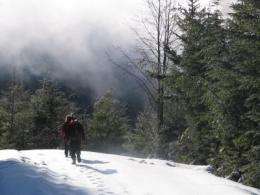NASA tech zooms in on water and land

In a pilot project that could help better manage the planet's strained natural resources, space-age technologies are helping a Washington state community monitor its water availability. NASA satellites and sensors are providing the information needed to make more accurate river flow predictions on a daily basis.
"World leaders are struggling to protect natural resources for future generations," said Jeff Ward, a senior research scientist at the Department of Energy's Pacific Northwest National Laboratory, which is managed by Battelle. "These tools help us sustainably use natural resources while balancing environmental, cultural and economic concerns."
Ward manages a project on behalf of Battelle that is helping to better predict the flow of the Dungeness River, near Sequim, Wash., with data collected by NASA instruments. The project started by creating a new model that predicts river flows in the river's surrounding valley. It then expanded to help other communities in Kansas, Maine, Oregon and Washington state better manage their water and land resources with similar technologies.
The project - called the North Olympic Peninsula Solutions Network - is lead by the North Olympic Peninsula Resource Conservation & Development Council and supported by PNNL and others.
Lucien Cox of NASA will present the project's results Dec. 16 at the 2009 fall meeting of the American Geophysical Union in San Francisco.
The project will help regional natural resource managers assess the abundance - or lack thereof - of the Dungeness River. The river model was developed to show how NASA technologies like satellites, sensors and computational models could be used to improve short-term stream flow predictions. The river model relies on snowpack and temperature data collected from satellites, as well as real-time snowpack and water data collected by various agencies.
The new Dungeness River model's calculations can tell what kind of flow to expect - from a trickle to a deluge - on a daily and monthly basis. Before, resource managers primarily relied on either water levels physically measured at gauges or historical data to predict total expected water volume over two to six months. Neither method provided flow predictions as frequently as the new model.
Having more precise river flow predictions is especially important along the Dungeness River, where the towering Olympic Mountains create a drying rain shadow effect and steep slopes prevent above-ground water reservoirs. Sequim receives just 15 inches of rain annually. Water is so treasured that the agricultural city is home to a 114-year-old festival that celebrates a historic irrigation system.
"Improving the accuracy of stream flow predictions is important to a diverse group of water users, including irrigation-dependent farmers, planners making urban growth decisions and those concerned about salmon survival or water quality," said Clea Rome, North Olympic Peninsula RC&D coordinator. "Stream flow prediction tools can help us avoid a crisis by alerting us before droughts are in full effect, giving us enough notice to adjust water use."
But the practical use of NASA technologies isn't limited just to Sequim or river water. The North Olympic Peninsula Solutions Network is helping four other resource, conservation and development councils tackle their unique problems.
Another resource - soil - has the Solomon Valley RC&D in north central Kansas concerned about agricultural tilling and erosion. Striking a balance between agriculture and forestry is critical for the Threshold to Maine RC&D in southwest Maine. The Wy'East RC&D is looking to better manage water supply and demand in north central Oregon. And in Okanogan, Wash., the possibility of water shortages worries the North Central Washington RC&D.
"Space technologies can help us get the best science to the ground, to the decision makers here in the Okanogan Basin," said Samantha Bartling, North Central Washington RC&D coordinator. "We expect it'll help us more precisely predict water availability for a long time to come."
The four councils are working with North Olympic Peninsula Solutions Network leaders to determine how NASA technologies can best address their different challenges.
More information: "NASA Water-Cycle Solutions Networks and Community of Practice Approaches to enhance Decision-making." Lucien Cox (NASA), Jeff Ward (PNNL) and Will Pozzi (WaterNet). 5:45-6 p.m., Dec. 16. Room 301, Moscone South, Moscone Convention Center, San Francisco.
Provided by Pacific Northwest National Laboratory
















